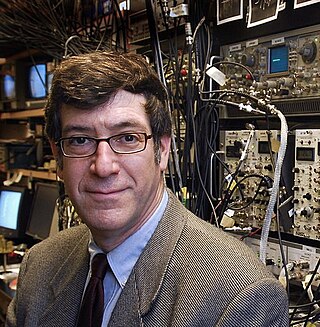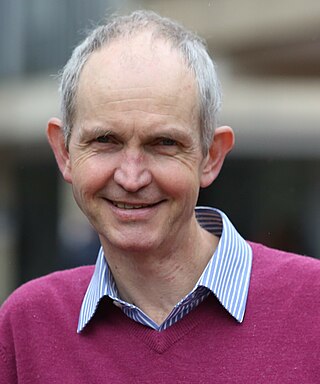The Kuzyk quantum gap is a discrepancy between the maximum value of the nonlinear-optical susceptibility allowed by quantum mechanics and the highest values actually observed in real molecules. The highest possible value is known as the Kuzyk limit, after its discoverer Professor Mark G. Kuzyk of Washington State University.

An optical fiber, or optical fibre, is a flexible glass or plastic fiber that can transmit light from one end to the other. Such fibers find wide usage in fiber-optic communications, where they permit transmission over longer distances and at higher bandwidths than electrical cables. Fibers are used instead of metal wires because signals travel along them with less loss and are immune to electromagnetic interference. Fibers are also used for illumination and imaging, and are often wrapped in bundles so they may be used to carry light into, or images out of confined spaces, as in the case of a fiberscope. Specially designed fibers are also used for a variety of other applications, such as fiber optic sensors and fiber lasers.
Chen Yung-Jui received his BS in Physics from National Tsing Hua University in 1969 and Ph.D. in Physics at the University of Pennsylvania (1976). After a brief postdoctoral period at Penn, he joined the Advanced Microelectronic Laboratory at McDonnell Douglas Astronautics Co. in 1977. From 1980 to 1987, Dr. Chen conducted fiber optical communications related research at GTE Laboratories. During the ten years in industry, he worked on MOS/MNOS VLSI technology, wafer scale integration, Ultra-fast optical spectroscopy, nonlinear optics of semiconductors and organic polymers, integrated optics and optoelectronic devices. In 1987, he moved to academe and became one of the founding faculty members of the Department of Electrical Engineering at University of Maryland, Baltimore County.
Intrinsic hyperpolarizability in physics, mathematics and statistics, is a scale invariant quantity that can be used to compare molecules of different sizes. The intrinsic hyperpolarizability is defined as the hyperpolarizability divided by the Kuzyk Limit. This quantity is scale invariant and thus is independent of the energy scale and number of electrons in a molecule that is being evaluated for its nonlinear optical response. Therefore, it can be used to compare molecules of different shapes and sizes.

The Institute of Optics is a department and research center at the University of Rochester in Rochester, New York. The institute grants degrees at the bachelor's, master's and doctoral levels through the University of Rochester School of Engineering and Applied Sciences. Since its founding, the institute has granted over 2,500 degrees in optics, making up about half of the degrees awarded in the field in the United States. The institute is made up of 20 full-time professors, 12 professors with joint appointments in other departments, 10 adjunct professors, 5 research scientists, 11 staff, about 170 undergraduate students and about 110 graduate students.
Seth R. Marder is an American physical chemist best known for his development of the quantum mechanical foundations of nonlinear electro-optics in organic dyes and materials.

Mark George Raizen is an American physicist who conducts experiments on quantum optics and atom optics.

Jonathan P. Dowling was an Irish-American researcher and professor in theoretical physics, known for his work on quantum technology, particularly for exploiting quantum entanglement for applications to quantum metrology, quantum sensing, and quantum imaging.

Vladimir (Vlad) M. Shalaev is a Distinguished Professor of Electrical and Computer Engineering and Scientific Director for Nanophotonics at Birck Nanotechnology Center, Purdue University.

The University of Arizona College of Optical Sciences, considered the largest institute for optics education in the United States, is dedicated to research and education in optics with an emphasis on optical engineering. The college offers more than 90 courses in optical sciences, and a Bachelor of Science degree in Optical Sciences and Engineering, Masters and Doctoral degree programs in Optical Sciences, as well as a dual master's degree in Optical Sciences and Business Administration. The college also offers comprehensive distance learning courses leading to a Professional Graduate Certificate or a master's degree and markets non-credit short courses on DVD to optics professionals.

Robert Louis Byer is a physicist. He was president of the Optical Society of America in 1994 and of the American Physical Society in 2012.

Anthony Michael Johnson is an American experimental physicist, a professor of physics, and a professor of computer science and electrical engineering at the University of Maryland, Baltimore County (UMBC). He is the director of the Center for Advanced Studies in Photonics Research (CASPR), also situated on campus at UMBC. Since his election to the 2002 term as president of the Optical Society, formerly the Optical Society of America, Johnson has the distinction of being the first and only African-American president to date. Johnson's research interests include the ultrafast photophysics and nonlinear optical properties of bulk, nanostructured, and quantum well semiconductor structures, ultrashort pulse propagation in fibers and high-speed lightwave systems. His research has helped to better understand processes that occur in ultrafast time frames of 1 quadrillionth of a second. Ultrashort pulses of light have been used to address technical and logistical challenges in medicine, telecommunications, homeland security, and have many other applications that enhance contemporary life.
Girish S. Agarwal, Fellow of the Royal Society UK, is a theoretical physicist. He is currently at the Texas A & M University with affiliations to the Departments of Biological and Agricultural Engineering, Physics and Astronomy, and the Institute for Quantum Science and Engineering. Earlier he worked as Noble Foundation Chair and the Regents Professor at the Oklahoma State University. He is a recognized leader in the field of quantum optics and also has made major contributions to the fields of nonlinear optics, nanophotonics and plasmonics. In 2013 he published the textbook "Quantum Optics", covering a wide range of recent developments in the field, which has been well received by the community.

Robert William Boyd is an American physicist noted for his work in optical physics and especially in nonlinear optics. He is currently the Canada Excellence Research Chair Laureate in Quantum Nonlinear Optics based at the University of Ottawa, professor of physics cross-appointed to the school of electrical engineering and computer science at the University of Ottawa, and professor of optics and professor of physics at the University of Rochester.
John Michael Dudley is a physicist and currently Professor of Physics at the University Bourgogne Franche-Comté working at the joint University-CNRS research Institute FEMTO-ST in Besançon, France. Originally from New Zealand, he is known for his research in nonlinear and ultrafast optical physics, for service to international scientific societies, and for initiatives in promoting international scientific outreach and the public communication of science.

Jonathan C. Knight, is a British physicist. He is the Pro Vice-Chancellor (Research) for the University of Bath where he has been Professor in the Department of Physics since 2000, and served as head of department. From 2005 to 2008, he was founding Director of the university's Centre for Photonics and Photonic Materials.
Govind P. Agrawal is an Indian American physicist and a fellow of Optica, Life Fellow of the IEEE, and Distinguished Fellow of the Optical Society of India. He is the recipient of James C. Wyant Professorship of Optics at the Institute of Optics and a professor of physics at the University of Rochester. He is also a Distinguished scientist at the Laboratory for Laser Energetics (LLE) in the University of Rochester. Agrawal has authored and co-authored several highly cited books in the fields of non-linear fiber optics, optical communications, and semiconductor lasers.
Arsenic(III) telluride is an inorganic compound with the chemical formula As2Te3. It exists in two forms, the monoclinic α phase which transforms under high pressure to a rhombohedral β phase. The compound is a semiconductor, with most current carried by holes. Arsenic telluride has been examined for its use in nonlinear optics.
Alexander Luis Gaeta is an American physicist and the David M. Rickey Professor of Applied Physics at Columbia University. He is known for his work on quantum and nonlinear photonics. He is a Fellow of the American Physical Society, Optica, and of the Institute of Electrical and Electronics Engineers.
John Ballato is an American materials scientist, entrepreneur, and academic. He holds the J. E. Sirrine Endowed Chair of Optical Fiber and is a professor of materials science and engineering, electrical and computer engineering, as well as physics and astronomy at Clemson University. He has received many international recognitions for his research on optical and optoelectronic materials, particularly as relates to optical fiber.









